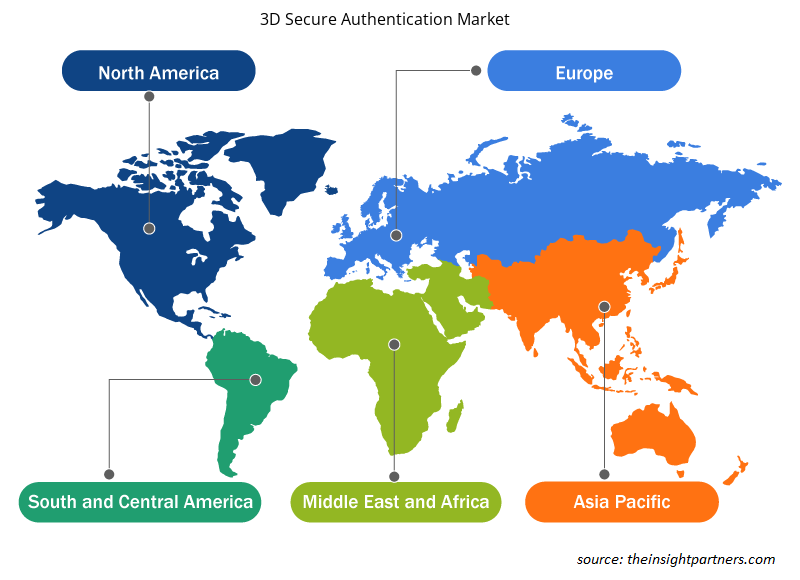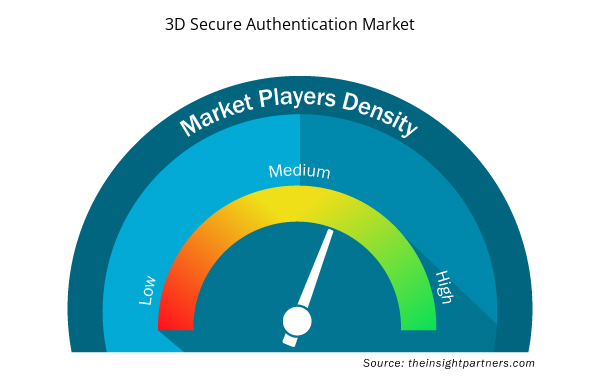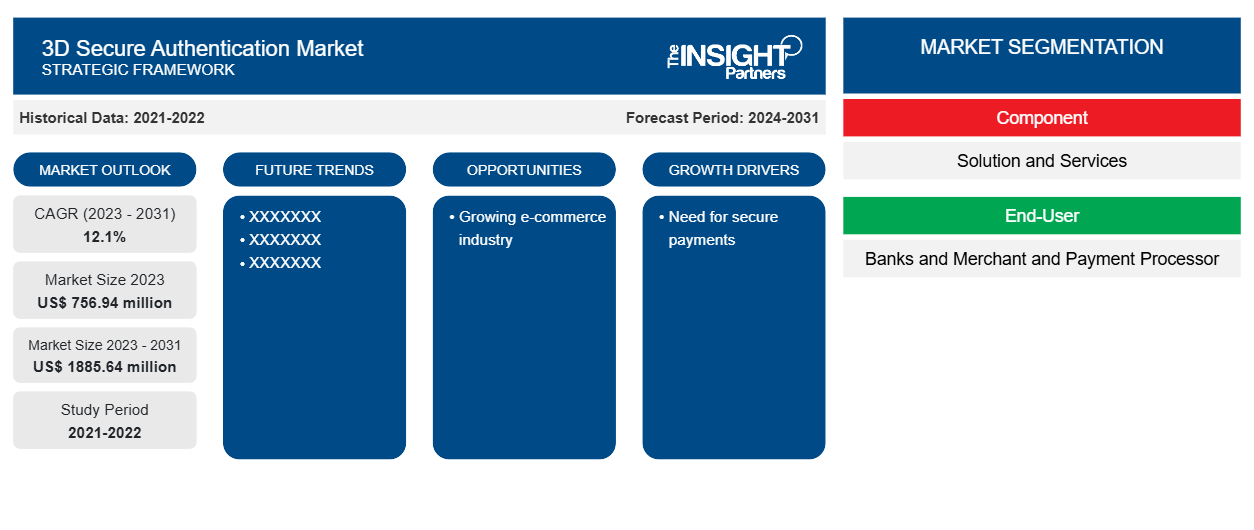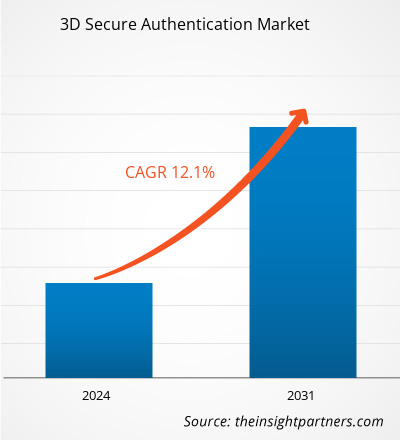Der Markt für sichere 3D-Authentifizierung soll von 756,94 Millionen US-Dollar im Jahr 2023 auf 1885,64 Millionen US-Dollar im Jahr 2031 anwachsen. Der Markt wird zwischen 2023 und 2031 voraussichtlich eine durchschnittliche jährliche Wachstumsrate von 12,1 % verzeichnen. Steigende Online-Transaktionen und zunehmende Cyberangriffe dürften weiterhin die wichtigsten Trends auf dem Markt bleiben.
Marktanalyse für sichere 3D-Authentifizierung
Die zunehmende Internetdurchdringung, das steigende verfügbare Einkommen der Verbraucher und die zunehmende Nutzung der Digitalisierung sind einige der Faktoren, die das Marktwachstum vorantreiben. Die wachsende E-Commerce- und M-Commerce-Branche erzeugt die Nachfrage nach Lösungen zur Absicherung von Transaktionen, was zu Marktwachstum führt. Mit der wachsenden Zahl von Online-Transaktionen treibt die Sorge vor Online-Betrug den Markt an.
Marktübersicht für 3D Secure Authentication
3D Secure (3DS) ist eine Authentifizierungsmethode und ein Sicherheitsprototyp, der von Unternehmen zur Absicherung ihres Zahlungsökosystems eingesetzt wird . Es bietet eine zusätzliche Sicherheitsebene für Kreditkartentransaktionen. Dieser Authentifizierungsprozess überprüft die Identität des Kunden während der Zahlung. Die strenge Authentifizierungsverordnung PSD2 in Europa und ähnliche Verordnungen in Großbritannien, Indien und Australien fördern die Einführung von sicheren 3D-Authentifizierungslösungen für Kartenzahlungen.
Passen Sie diesen Bericht Ihren Anforderungen an
Sie erhalten kostenlose Anpassungen an jedem Bericht, einschließlich Teilen dieses Berichts oder einer Analyse auf Länderebene, eines Excel-Datenpakets sowie tolle Angebote und Rabatte für Start-ups und Universitäten.
- Holen Sie sich die wichtigsten Markttrends aus diesem Bericht.Dieses KOSTENLOSE Beispiel umfasst eine Datenanalyse von Markttrends bis hin zu Schätzungen und Prognosen.
Markttreiber und Chancen für die sichere 3D-Authentifizierung
Notwendigkeit sicherer Zahlungen.
Mit der zunehmenden Digitalisierung übernehmen Unternehmen digitale Lösungen, um ihre Geschäftsabläufe effizient zu gestalten. Dieser Faktor führt zur Einführung von Lösungen, die Zahlungen zwischen Unternehmen tätigen und einziehen. Die Sicherung des Zahlungsökosystems hat für jedes Unternehmen höchste Priorität, da der Aufbau und Erhalt des Kundenvertrauens wichtig ist. Zu diesem Zweck übernehmen Unternehmen sichere 3D-Authentifizierungslösungen, um eine zusätzliche Sicherheitsebene hinzuzufügen und unbefugte Online-Transaktionen zu verhindern.
Wachsende E-Commerce-Branche
Die E-Commerce-Branche gewinnt aufgrund der zunehmenden Internetdurchdringung, Smartphone- Verkäufe und der steigenden Kaufkraft der Verbraucher an Bedeutung. Die Machbarkeit, die erschwinglichen Preise und das breite Produktportfolio sind einige der Vorteile des Online-Shoppings gegenüber dem traditionellen Einkauf. Daher neigen Kunden dazu, über E-Commerce-Plattformen einzukaufen. Dies hat zu erhöhten Zahlungen der Kunden geführt, was wiederum den Markt für sichere 3D-Authentifizierung hervorgebracht hat. Die sichere 3D-Authentifizierung hilft Unternehmen und Kunden, sicherere Online-Transaktionen durchzuführen. Die Einführung dieser Lösung verringert das Betrugsrisiko und bietet mehr Sicherheit durch eine zusätzliche Authentifizierungsebene.
Segmentierungsanalyse des Marktberichts zur sicheren 3D-Authentifizierung
Wichtige Segmente, die zur Ableitung der Marktanalyse für sichere 3D-Authentifizierung beigetragen haben, sind die Komponente und der Endbenutzer.
- Basierend auf der Komponente ist der Markt für sichere 3D-Authentifizierung in Lösungen und Dienste unterteilt. Das Lösungssegment hatte im Jahr 2023 den größten Marktanteil.
- Basierend auf dem Endbenutzer ist der Markt für sichere 3D-Authentifizierung in Banken sowie Händler und Zahlungsabwickler unterteilt. Das Bankensegment hielt im Jahr 2023 einen erheblichen Marktanteil.
Marktanteilsanalyse für sichere 3D-Authentifizierung nach geografischer Lage
Der geografische Umfang des Marktberichts zur sicheren 3D-Authentifizierung ist hauptsächlich in fünf Regionen unterteilt: Nordamerika, Asien-Pazifik, Europa, Naher Osten und Afrika sowie Süd- und Mittelamerika.
Der asiatisch-pazifische Raum hatte den größten Marktanteil und wird voraussichtlich mit der höchsten durchschnittlichen jährlichen Wachstumsrate wachsen. Länder wie Indien, Japan und China halten den größten Marktanteil im asiatisch-pazifischen Raum. Die Einführung digitaler Technologien treibt das Marktwachstum in der Region an. Die wachsende E-Commerce-Branche trägt zum Wachstum des Marktes für sichere 3D-Authentifizierung bei.
Regionale Einblicke in den Markt für sichere 3D-Authentifizierung
Die regionalen Trends und Faktoren, die den Markt für sichere 3D-Authentifizierung im Prognosezeitraum beeinflussen, wurden von den Analysten von Insight Partners ausführlich erläutert. In diesem Abschnitt werden auch die Marktsegmente und die Geografie für sichere 3D-Authentifizierung in Nordamerika, Europa, im asiatisch-pazifischen Raum, im Nahen Osten und Afrika sowie in Süd- und Mittelamerika erörtert.

- Holen Sie sich die regionalspezifischen Daten für den 3D Secure Authentication-Markt
Umfang des Marktberichts zur sicheren 3D-Authentifizierung
| Berichtsattribut | Details |
|---|---|
| Marktgröße im Jahr 2023 | 756,94 Millionen US-Dollar |
| Marktgröße bis 2031 | 1885,64 Millionen US-Dollar |
| Globale CAGR (2023 - 2031) | 12,1 % |
| Historische Daten | 2021-2022 |
| Prognosezeitraum | 2024–2031 |
| Abgedeckte Segmente | Nach Komponente
|
| Abgedeckte Regionen und Länder | Nordamerika
|
| Marktführer und wichtige Unternehmensprofile |
|
Dichte der Marktteilnehmer für sichere 3D-Authentifizierung: Auswirkungen auf die Geschäftsdynamik verstehen
Der Markt für sichere 3D-Authentifizierung wächst rasant. Dies wird durch die steigende Nachfrage der Endnutzer aufgrund von Faktoren wie sich entwickelnden Verbraucherpräferenzen, technologischen Fortschritten und einem größeren Bewusstsein für die Vorteile des Produkts vorangetrieben. Mit der steigenden Nachfrage erweitern Unternehmen ihr Angebot, entwickeln Innovationen, um die Bedürfnisse der Verbraucher zu erfüllen, und nutzen neue Trends, was das Marktwachstum weiter ankurbelt.
Die Marktteilnehmerdichte bezieht sich auf die Verteilung der Firmen oder Unternehmen, die in einem bestimmten Markt oder einer bestimmten Branche tätig sind. Sie gibt an, wie viele Wettbewerber (Marktteilnehmer) in einem bestimmten Marktraum im Verhältnis zu seiner Größe oder seinem gesamten Marktwert präsent sind.
Die wichtigsten Unternehmen auf dem Markt für sichere 3D-Authentifizierung sind:
- Netcetera
- Gpayment Pvt Ltd.
- ASEE-GRUPPE
- Asiapay Limited
- Modirum
- Msignia, Inc.
Haftungsausschluss : Die oben aufgeführten Unternehmen sind nicht in einer bestimmten Reihenfolge aufgeführt.

- Überblick über die wichtigsten Akteure auf dem Markt für sichere 3D-Authentifizierung
Marktnachrichten und aktuelle Entwicklungen zur 3D Secure-Authentifizierung
Der Markt für sichere 3D-Authentifizierung wird durch die Erfassung qualitativer und quantitativer Daten nach Primär- und Sekundärforschung bewertet, die wichtige Unternehmensveröffentlichungen, Verbandsdaten und Datenbanken umfasst. Nachfolgend sind einige der Entwicklungen auf dem Markt für sichere 3D-Authentifizierung aufgeführt:
- Everlink gab den Abschluss der 3D Secure-Zertifizierung und die Einführung seines 3D Secure Authentication Service über den VISA Consumer Authentication Service (VCAS) für Visa- und Mastercard-Kartenprodukte bekannt. Da der E-Commerce weltweit an Fahrt gewinnt, müssen Unternehmen Betrug verhindern und sicherstellen, dass Transaktionen reibungslos genehmigt werden. Derzeit erfolgen mehr als 79 % aller Betrugsfälle durch Transaktionen ohne Karte. Die 3D Secure-Authentifizierung bietet Verbrauchern eine zusätzliche Sicherheitsebene und bietet ein verbessertes, flexibleres Karteninhabererlebnis für Transaktionen ohne Karte auf mehreren Geräten. (Quelle: Everlink, Pressemitteilung, Januar 2022)
- PayU, Indiens führender Anbieter von Online-Zahlungslösungen, hat die Einführung des 3D Secure 2.0 SDK angekündigt, das einen vollständigen nativen Checkout und ein hervorragendes Kundenerlebnis für alle Kartentransaktionen bietet. PayU-Händler können ein optimiertes Kundenerlebnis bieten und gleichzeitig die wichtigsten Upgrades der Kartennetzwerke – einschließlich Visa und Mastercard – einhalten und gleichzeitig eine bessere Sicherheit und einen besseren Betrugsschutz erhalten. Das leichte 3DS 2.0 SDK von PayU bietet geringere Latenzzeiten und eine Verkürzung der Checkout-Zeit um 40 %. PayU hat dieses EMVCo-zertifizierte Angebot in Zusammenarbeit mit Wibmo entwickelt, einem PayU-eigenen globalen Full-Stack-PayTech-Unternehmen. (Quelle: Procurato, Pressemitteilung, Februar 2023)
Marktbericht zur sicheren 3D-Authentifizierung – Abdeckung und Ergebnisse
Der Bericht „Marktgröße und Prognose für sichere 3D-Authentifizierung (2021–2031)“ bietet eine detaillierte Analyse des Marktes, die die folgenden Bereiche abdeckt:
- Marktgröße und Prognose für sichere 3D-Authentifizierung auf globaler, regionaler und Länderebene für alle wichtigen Marktsegmente, die im Rahmen des Projekts abgedeckt sind
- Markttrends und Marktdynamiken für sichere 3D-Authentifizierung wie Treiber, Einschränkungen und wichtige Chancen
- Detaillierte PEST/Porters Five Forces- und SWOT-Analyse
- Marktanalyse für sichere 3D-Authentifizierung mit Blick auf wichtige Markttrends, globale und regionale Rahmenbedingungen, wichtige Akteure, Vorschriften und aktuelle Marktentwicklungen
- Branchenlandschaft und Wettbewerbsanalyse mit Marktkonzentration, Heatmap-Analyse, prominenten Akteuren und aktuellen Entwicklungen für den Markt für sichere 3D-Authentifizierung
- Detaillierte Firmenprofile
- Historische Analyse (2 Jahre), Basisjahr, Prognose (7 Jahre) mit CAGR
- PEST- und SWOT-Analyse
- Marktgröße Wert/Volumen – Global, Regional, Land
- Branche und Wettbewerbsumfeld
- Excel-Datensatz



Report Coverage
Revenue forecast, Company Analysis, Industry landscape, Growth factors, and Trends

Segment Covered
This text is related
to segments covered.

Regional Scope
North America, Europe, Asia Pacific, Middle East & Africa, South & Central America

Country Scope
This text is related
to country scope.
Häufig gestellte Fragen
The adoption of AI and ML technologies to prevent potential risks is considered a key trend in the 3D secure authentication market.
The global 3D secure authentication market is estimated to register a CAGR of 12.1% during the forecast period 2023–2031.
Rising online transactions and growing cyberattacks are the key driving factors impacting the 3D secure authentication market.
The estimated value of the 3D secure authentication market will be US$ 1885.64 million by 2031.
Netcetera; Gpayment Pvt Ltd.; ASEE GROUP; Asiapay Limited; Modirum; Msignia, Inc.; Ravelin Technology Ltd; RS Software; UL LLC; and Izealiant Technologies Pvt. Ltd. are some of the key players operating in the 3D secure authentication market.
Trends and growth analysis reports related to Technology, Media and Telecommunications : READ MORE..
The Insight Partners performs research in 4 major stages: Data Collection & Secondary Research, Primary Research, Data Analysis and Data Triangulation & Final Review.
- Data Collection and Secondary Research:
As a market research and consulting firm operating from a decade, we have published and advised several client across the globe. First step for any study will start with an assessment of currently available data and insights from existing reports. Further, historical and current market information is collected from Investor Presentations, Annual Reports, SEC Filings, etc., and other information related to company’s performance and market positioning are gathered from Paid Databases (Factiva, Hoovers, and Reuters) and various other publications available in public domain.
Several associations trade associates, technical forums, institutes, societies and organization are accessed to gain technical as well as market related insights through their publications such as research papers, blogs and press releases related to the studies are referred to get cues about the market. Further, white papers, journals, magazines, and other news articles published in last 3 years are scrutinized and analyzed to understand the current market trends.
- Primary Research:
The primarily interview analysis comprise of data obtained from industry participants interview and answers to survey questions gathered by in-house primary team.
For primary research, interviews are conducted with industry experts/CEOs/Marketing Managers/VPs/Subject Matter Experts from both demand and supply side to get a 360-degree view of the market. The primary team conducts several interviews based on the complexity of the markets to understand the various market trends and dynamics which makes research more credible and precise.
A typical research interview fulfils the following functions:
- Provides first-hand information on the market size, market trends, growth trends, competitive landscape, and outlook
- Validates and strengthens in-house secondary research findings
- Develops the analysis team’s expertise and market understanding
Primary research involves email interactions and telephone interviews for each market, category, segment, and sub-segment across geographies. The participants who typically take part in such a process include, but are not limited to:
- Industry participants: VPs, business development managers, market intelligence managers and national sales managers
- Outside experts: Valuation experts, research analysts and key opinion leaders specializing in the electronics and semiconductor industry.
Below is the breakup of our primary respondents by company, designation, and region:

Once we receive the confirmation from primary research sources or primary respondents, we finalize the base year market estimation and forecast the data as per the macroeconomic and microeconomic factors assessed during data collection.
- Data Analysis:
Once data is validated through both secondary as well as primary respondents, we finalize the market estimations by hypothesis formulation and factor analysis at regional and country level.
- Macro-Economic Factor Analysis:
We analyse macroeconomic indicators such the gross domestic product (GDP), increase in the demand for goods and services across industries, technological advancement, regional economic growth, governmental policies, the influence of COVID-19, PEST analysis, and other aspects. This analysis aids in setting benchmarks for various nations/regions and approximating market splits. Additionally, the general trend of the aforementioned components aid in determining the market's development possibilities.
- Country Level Data:
Various factors that are especially aligned to the country are taken into account to determine the market size for a certain area and country, including the presence of vendors, such as headquarters and offices, the country's GDP, demand patterns, and industry growth. To comprehend the market dynamics for the nation, a number of growth variables, inhibitors, application areas, and current market trends are researched. The aforementioned elements aid in determining the country's overall market's growth potential.
- Company Profile:
The “Table of Contents” is formulated by listing and analyzing more than 25 - 30 companies operating in the market ecosystem across geographies. However, we profile only 10 companies as a standard practice in our syndicate reports. These 10 companies comprise leading, emerging, and regional players. Nonetheless, our analysis is not restricted to the 10 listed companies, we also analyze other companies present in the market to develop a holistic view and understand the prevailing trends. The “Company Profiles” section in the report covers key facts, business description, products & services, financial information, SWOT analysis, and key developments. The financial information presented is extracted from the annual reports and official documents of the publicly listed companies. Upon collecting the information for the sections of respective companies, we verify them via various primary sources and then compile the data in respective company profiles. The company level information helps us in deriving the base number as well as in forecasting the market size.
- Developing Base Number:
Aggregation of sales statistics (2020-2022) and macro-economic factor, and other secondary and primary research insights are utilized to arrive at base number and related market shares for 2022. The data gaps are identified in this step and relevant market data is analyzed, collected from paid primary interviews or databases. On finalizing the base year market size, forecasts are developed on the basis of macro-economic, industry and market growth factors and company level analysis.
- Data Triangulation and Final Review:
The market findings and base year market size calculations are validated from supply as well as demand side. Demand side validations are based on macro-economic factor analysis and benchmarks for respective regions and countries. In case of supply side validations, revenues of major companies are estimated (in case not available) based on industry benchmark, approximate number of employees, product portfolio, and primary interviews revenues are gathered. Further revenue from target product/service segment is assessed to avoid overshooting of market statistics. In case of heavy deviations between supply and demand side values, all thes steps are repeated to achieve synchronization.
We follow an iterative model, wherein we share our research findings with Subject Matter Experts (SME’s) and Key Opinion Leaders (KOLs) until consensus view of the market is not formulated – this model negates any drastic deviation in the opinions of experts. Only validated and universally acceptable research findings are quoted in our reports.
We have important check points that we use to validate our research findings – which we call – data triangulation, where we validate the information, we generate from secondary sources with primary interviews and then we re-validate with our internal data bases and Subject matter experts. This comprehensive model enables us to deliver high quality, reliable data in shortest possible time.


 Holen Sie sich ein kostenloses Muster für diesen Bericht
Holen Sie sich ein kostenloses Muster für diesen Bericht